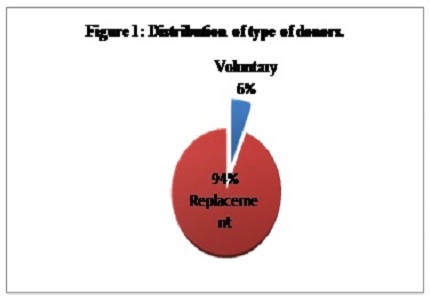Seroprevalence of Human Immunodeficiency Virus infection among blood donors of central Karnataka
Abstract
Introduction: Transfusion of blood and blood products is life saving procedure which benefits numerous patients worldwide, as transfusion of blood or its components is an integral part of medical and surgical management. At the same time it is an important route of transmission of infection to the recipients. Seroprevalence of HIV among blood donors is important mode of transmission, which can be reduced by practicing 100% voluntary donation and strict donor screening. Study was conducted to find out the seroprevalence of HIV among blood donors with respect to type of the donor, age, sex and blood group of the donor.
Methodology: This study was conducted from January 2005 to December 2009 at the blood bank of tertiary care Medical College Hospital, serving people of Central Karnataka. Blood units collected from eligible blood donors were subjected to 4th generation ELISA for screening for IgG antibodies to HIV. Prevalence of HIV infection was noted using SPSS version 13 statistical package in relation to type of donor, age, sex and blood group of donor. Significance of the trend was determined by chi square test.
Result: Total of 19,413 donors were screened during the study period. Majority (94%) of donors were replacement donors and 46.13% of donors belonged to the age group 18 to 25 years. Overall seroprevalence of HIV was 0.5%. Seroprevalence was more in replacement donors as compared to voluntary donors.
Conclusion: Seroprevalence detected by immunoassay testing represents only tip of the iceberg. This could be reduced by 100% voluntary blood donation.
Downloads
References
2. Rodrigo C, Rajapakse S. Current status of HIV/AIDS in South Asia. J Glob Infect Dis. 2009 Jul;1(2):93-101. doi: 10.4103/0974-777X.56249.
3. Pagaro PM, Pandit DP, Patel AR, Chaudhari U. Seroprevalence of human immunodeficiency virus in voluntary blood donors: Declining trend. Med J DY Patil Univ 2013; 6(3): 236-9.
4. Ekadashi R, Langer S. Seroprevalence of Human Immunodeficiency Virus and Syphilis in Blood Donors of Delhi. Indian Journal of Medical Microbiology 2009; 27(2): 167-168.
5. Giri PA, Deshpande JD, Phalke DB, Karle LB. Seroprevalence of transfusion transmissible infections among voluntary blood donors at a tertiary care teaching hospital in rural area of India. J Family Med Prim Care. 2012 Jan;1(1):48-51. doi: 10.4103/2249-4863.94452.
6. Pahuja S, Sharma M, Baitha B, Jain M. Prevalence and trends of markers of hepatitis C virus, hepatitis B virus and human immunodeficiency virus in Delhi blood donors: A hospital based study. Jpn J Infect Dis. 2007 Nov;60(6):389-91.
7. Arora D, Arora B, Khetarpal A. Seroprevalence of HIV, HBV, HCV and syphilis in blood donors in Southern Haryana. Indian J Pathol Microbiol. 2010 Apr-Jun;53(2):308-9. doi: 10.4103/0377-4929.64295.
8. Naskar S, Nandy S, Basu K, Basu R. Study of seroprevalence of HIV, Hepatits B and C and Syphilis among blood donors in a tertiary care hospital, Kolkata. IOSR Journal of Dental and Medical Sciences 2013; 11(3): 63-66.
9. Pallavi P, Ganesh CK, Jayashree K, Manjunath GV. Seroprevalence and trends in transfusion transmitted infections among blood donors in a university hospital blood bank: A 5 year studyIndian J Hematol Blood Transfus. 2011 Mar;27(1):1-6. doi: 10.1007/s12288-010-0047-x. Epub 2010 Dec 14.
10. Patel PJ. Transfusion transmissible infections in blood donors: A 7-year study in central Gujarat. Med J DY Patil Univ 2014; 7: 620-4.
11. Sastry Jayagowri M, Agawane Shubhangi U, Harke Vimal A. Retrospective study of the five-Year Prevalence and trends of transfusion transmitted infections (TTIs) among blood donors at a charitable hospital blood bank in Pune, India. International J. of Healthcare and Biomedical Research 2014; 2(3): 193-200.
12. Kumar A, Sharma SM, Ingole NS, Gangane N. Seroprevalence of Transfusion Transmissible Infections (TTIs) among blood donors in a tertiary care hospital, central India: A prospective study. Muller J Med Sci Res 2014; 5: 113-6.
13. Chigurupati P, Murthy KS. Automated nucleic acid amplification testing in blood banks: An additional layer of blood safety. Asian J Transfus Sci. 2015; 9(1): 9-11.



 OAI - Open Archives Initiative
OAI - Open Archives Initiative


